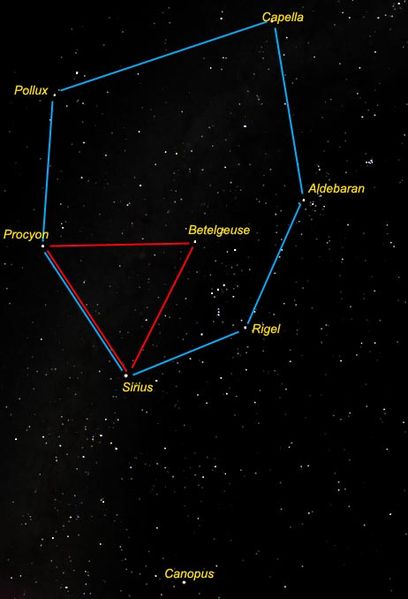
On February 14 and 15, 2019, you’ll find the waxing gibbous moon shining inside a large asterism that we in the Northern Hemisphere often call the Winter Circle. It’s a very large star configuration made of brilliant winter stars. Around the world on this night, the moon shines inside the Circle. From anywhere in the Northern Hemisphere, look for this pattern to fill up much of the eastern half of sky at nightfall. At 8 to 9 p.m., the Winter Circle will swing to your southern sky, and then it will drift into your western sky around midnight.
If you’re in the Southern Hemisphere … although it’s not winter for you, these same stars appear around the moon. But, for you, the Circle will appear upside-down with respect to our chart. The star Sirius will be at the top, instead of the bottom.
The Winter Circle is sometimes called the Winter Hexagon. It’s not one of the 88 recognized constellations, but instead an asterism – a pattern of stars that’s fairly easy to recognize. Our sky chart can’t adequately convey the Winter Circle’s humongous size! It dwarfs the constellation Orion the Hunter, which is a rather large constellation, occupying the southwestern part of the Winter Circle pattern.
Enjoying EarthSky so far? Sign up for our free daily newsletter today!

The Winter Circle in blue. It contains another asterism, or familiar star pattern – called the Winter Triangle – in red. These stars will be out in the evening sky for several months to come. Image via Wikimedia Commons.
Here’s how to locate the Winter Circle from mid-northern latitudes. At nightfall and early evening, look high overhead for the bright star Capella. This star marks the top (or more properly, the northern terminus) of the Winter Circle.
As Capella shines way overhead, the constellation Orion the Hunter is prowling in the southern sky. Draw a line downward through Orion’s Belt to find Sirius, the brightest star in the night sky. This star marks the bottom (the southern tip) of the Winter Circle, as seen from our Northern Hemisphere perspective
By the way, during these next few nights, the waxing gibbous moon shows you where the sun resides in front of the backdrop stars in June. So enjoy the Winter Circle. And contemplate the sun being in this part of the sky when summer returns to the Northern Hemisphere!

Ken Gallagher in Lake Havasu, Arizona, wrote in February, 2017: “Didn’t think the clouds would clear, but alas, they did. Enough to catch the Winter Circle. Hard to make out Aldebaran and Capella, but they are there.”
Bottom line: On the evening of February 14, 2019, the waxing gibbous moon shines inside the huge pattern of stars known as the Winter Circle. Be sure to notice the different colors of these stars!
More on the Winter Circle: Brightest winter stars
Year’s biggest supermoon on February 19
EarthSky lunar calendars are cool! They make great gifts. Order now.
from EarthSky http://bit.ly/2TPrvwP

On February 14 and 15, 2019, you’ll find the waxing gibbous moon shining inside a large asterism that we in the Northern Hemisphere often call the Winter Circle. It’s a very large star configuration made of brilliant winter stars. Around the world on this night, the moon shines inside the Circle. From anywhere in the Northern Hemisphere, look for this pattern to fill up much of the eastern half of sky at nightfall. At 8 to 9 p.m., the Winter Circle will swing to your southern sky, and then it will drift into your western sky around midnight.
If you’re in the Southern Hemisphere … although it’s not winter for you, these same stars appear around the moon. But, for you, the Circle will appear upside-down with respect to our chart. The star Sirius will be at the top, instead of the bottom.
The Winter Circle is sometimes called the Winter Hexagon. It’s not one of the 88 recognized constellations, but instead an asterism – a pattern of stars that’s fairly easy to recognize. Our sky chart can’t adequately convey the Winter Circle’s humongous size! It dwarfs the constellation Orion the Hunter, which is a rather large constellation, occupying the southwestern part of the Winter Circle pattern.
Enjoying EarthSky so far? Sign up for our free daily newsletter today!

The Winter Circle in blue. It contains another asterism, or familiar star pattern – called the Winter Triangle – in red. These stars will be out in the evening sky for several months to come. Image via Wikimedia Commons.
Here’s how to locate the Winter Circle from mid-northern latitudes. At nightfall and early evening, look high overhead for the bright star Capella. This star marks the top (or more properly, the northern terminus) of the Winter Circle.
As Capella shines way overhead, the constellation Orion the Hunter is prowling in the southern sky. Draw a line downward through Orion’s Belt to find Sirius, the brightest star in the night sky. This star marks the bottom (the southern tip) of the Winter Circle, as seen from our Northern Hemisphere perspective
By the way, during these next few nights, the waxing gibbous moon shows you where the sun resides in front of the backdrop stars in June. So enjoy the Winter Circle. And contemplate the sun being in this part of the sky when summer returns to the Northern Hemisphere!

Ken Gallagher in Lake Havasu, Arizona, wrote in February, 2017: “Didn’t think the clouds would clear, but alas, they did. Enough to catch the Winter Circle. Hard to make out Aldebaran and Capella, but they are there.”
Bottom line: On the evening of February 14, 2019, the waxing gibbous moon shines inside the huge pattern of stars known as the Winter Circle. Be sure to notice the different colors of these stars!
More on the Winter Circle: Brightest winter stars
Year’s biggest supermoon on February 19
EarthSky lunar calendars are cool! They make great gifts. Order now.
from EarthSky http://bit.ly/2TPrvwP

Aucun commentaire:
Enregistrer un commentaire